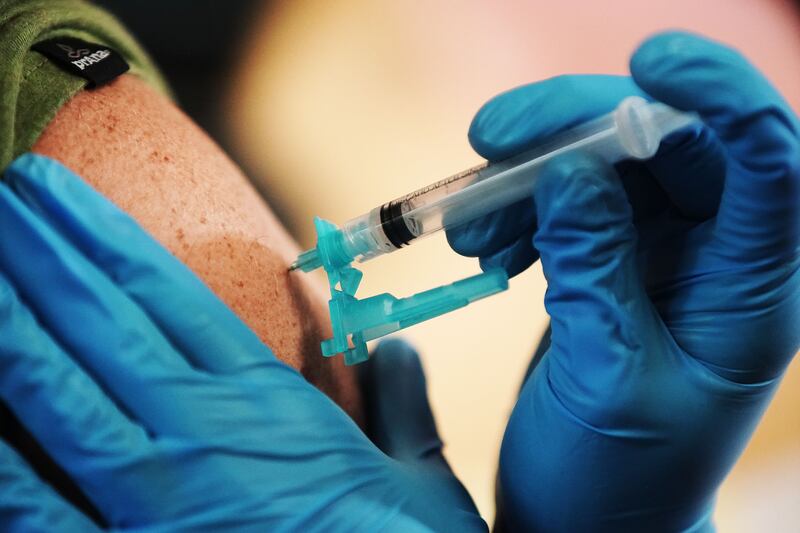Cases of COVID-19 in parts of Idaho are declining, and health officials in Utah say the state could see a dip in the coming weeks.
But hospitals and their staff remain strained, and doctors in both states are urging the public to stay vigilant and get vaccinated.
In Utah, capacity at Intermountain Healthcare’s COVID-19 intensive care unit hubs is 100%. Statewide, its ICUs are at 98%.
“We are still chock-full with COVID-19 patients which is making our capacity to be really strained,” Dr. Eddie Stenehjem, Intermountain Healthcare infectious diseases physician, told reporters.
On Friday, the Utah Department of Health reported 1,619 new cases and 10 deaths. The state currently has 530 people hospitalized with COVID-19. Jess Gomez, Intermountain Healthcare spokesman, said 196 of them are in ICUs.
The majority of the patients — 80% to 90% depending on the day — are not fully vaccinated.
Patients who are fully vaccinated and require hospitalization tend to have co-morbidities and are significantly older, Stenehjem said. The average unvaccinated patient hospitalized with COVID-19 at Intermountain is 50 year old. The average age of fully vaccinated patients is 70.
“They’re two very different populations,” Stenehjem said.
Officials did point to some hopeful numbers Friday.
Utah is currently “at a high plateau of cases” but has seen a slight, recent decline. Intermountain has also seen less patients in its emergency departments with “COVID-like symptoms” like a fever and cough. Stenehjem said that can be a “leading indicator of what’s to come.”
“That syndrome is starting to abate a bit, so we’re seeing a decrease in that, which may be an indicator that we’re going to start seeing cases come down here in the next couple weeks,” he said.
In Idaho, generally speaking, the state has seen a recent decline of cases.
“There is some good information from the state coming out,” Don Duffy, director of Idaho’s Panhandle Health District, told KXLY.com. “One of those is the positivity rate in the state. It had a high of 17% and it’s now down to 12%, so that’s positive, but that’s not what we’re seeing here in North Idaho.”
The northern stretches of the state, Duffy said, have a positivity rate of 27%, despite seeing a slight recent decline in hospitalizations.
Those figures have officials urging caution.
“It’s premature to say that we’re on a true downward trend at this point,” Dr. Peter Purrington, chief clinical officer for Heritage Health, told KXLY.com. “In north Idaho, we’re still seeing a high number of hospitalizations, a high number of patients requiring critical care, treatment and testing.”
During an Idaho Department of Health and Welfare briefing last week, Dr. Steve Nemerson, chief clinical officer for Idaho’s Saint Alphonsus Health System, said it’s time to start recognizing COVID-19 as an endemic rather than a pandemic, “which is a recognition of the reality that COVID-19 is with us to stay.”
“Sadly, today I’m here to tell you that we lost the war, that COVID-19 is here to stay,” he said.
Doctors on vaccine hesitancy: ‘We’re in a different time’
There are still many Utahns with reservations about the COVID-19 vaccine and Stenehjem has a message for them: “We’re in a very different time right now compared to where we were last March and April.”
“I could understand why people were hesitant at that time, and said, ‘Gosh, I’d really like to see more data,’” he said. But now, nearly eight months later, that data is available.
“These are likely the best studied vaccines in the entire world,” he said Friday, noting that the vaccines have been scrutinized to the point where Intermountain can stand behind their safety and efficacy with confidence.
“Start to think of the community as a whole. Think about your grandmother, your relative that might need one of these procedures but can’t get it done because of your negative opinion of the vaccine. Just get it,” said Dr. Edward Prince, orthopedic surgeon and medical director of surgical services at Intermountain St. George Regional Hospital, referring to the volume of important surgeries on hold due to the wave of unvaccinated COVID-19 patients at his hospital.
Currently, over 60% of eligible Utahns are fully vaccinated and swaths of the population that have already contracted COVID-19 have some level of protection, Stenehjem said, which paints a more positive outlook heading into the winter than in 2020, where cases shot up.
“We’re moving into the fall and winter with a population that is less susceptible to severe disease as compared to previously,” he said. “So the projections that we have take that into account.”
Halloween and the holidays: Can you go trick-or-treating?
With Halloween around the corner and the holidays approaching fast, the question of how to safely celebrate has been the subject of debate.
“We can’t forget that we are in the middle of a global pandemic ... we have to take precautions to prevent transmission,” Stenehjem said.
The doctor noted that because trick-or-treating is typically an outside event, it doesn’t pose the same risk as crowded, indoor gatherings. That’s what Stenehjem worries about, and he encouraged families and friends to avoid congregating inside with large groups of people.
“That’s when we’re going to see transmission,” he said.
And what if you have a family member who is unvaccinated, unwilling to mask up and doesn’t want to play ball? The “extreme” option, Stenehjem said, “is you could say, ‘then you can’t come.’”
Key to the decision should be assessing the risk to family members, said Stenehjem, adding people could also require a negative COVID-19 test within 48 hours of the unvaccinated coming into their home.
“If anybody is symptomatic with a respiratory illness that’s a nonstarter, they should not be joining the family gathering,” he said.


 alt=Kyle Dunphey
alt=Kyle Dunphey